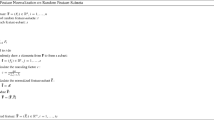Abstract
To select informative features from steganalytic features, a spatial-domain steganalytic feature selection method based on three-way interaction information and Kolmogorov–Smirnov (KS) test is proposed. Three-way interaction information is employed to rank all the features, and KS test is exploited to remove redundant features. Feature selection process of the proposed method is presented as follows: It calculates mutual information between features and the class label and selects the feature with the maximum value. Then, it loops to calculate three-way interaction information among each candidate feature, the previously selected feature and the class label and select the candidate feature with the maximum value. Following that, it calculates KS test between features and compares an obtained parameter with the predefined significance level for eliminating redundant features. To validate the performance of the proposed method, several typical feature ranking methods based on information measure and spatial-domain steganalytic feature selection methods are adopted for performance comparisons. Experimental results demonstrate that the proposed method can achieve better feature selection performance.



Similar content being viewed by others
References
Amin F, Fahmi A, Abdullah S, Ali A, Ahmed R, Ghani F (2018) Triangular cubic linguistic hesitant fuzzy aggregation operators and their application in group decision making. J Intell Fuzzy Syst 34(4):2401–2416
Bas P, Furon T (2007) Bows-2
Bennasar M, Setchi R, Hicks Y (2013) Feature interaction maximisation. Pattern Recognit Lett 34(14):1630–1635
Bennasar M, Hicks Y, Setchi R (2015) Feature selection using joint mutual information maximization. Expert Syst Appl 42(22):8520–8532
Chang C, Lin C (2011) Libsvm: a library for support vector machines. ACM Trans Intell Syst Technol 2(3):27
Cheddad A, Condell J, Curran K, Kevitt P (2010) Digital image steganography: survey and analysis of current methods. Signal Process 90(3):727–752
Estevez P, Tesmer M, Perez C, Zurada J (2009) Normalized mutual information feature selection. IEEE Trans Neural Netw 20(2):189–201
Fahmi A, Abdullah S, Amin F, Siddiqui N (2017) Aggregation operators on triangular cubic fuzzy numbers and its application to multi-criteria decision making problems. J Intell Fuzzy Syst 33(6):3323–3337
Fahmi A, Abdullah S, Amin F, Khan MA (2018a) Trapezoidal cubic fuzzy number einstein hybrid weighted averaging operators and its application to decision making. Soft Comput. https://doi.org/10.1007/s00500-018-3242-6
Fahmi A, Amin F, Abdullah S, Ali A (2018b) Cubic fuzzy Einstein aggregation operators and its application to decision making. Int J Syst Sci 49(11):2385–2397
Fayyad U, Irani K (1993) Multi-interval discretization of continuous-valued attributes for classification learning. In: Proceedings of international joint conference on artificial intelligence, pp 1022–1029
Fleuret F (2004) Fast binary feature selection with conditional mutual information. J Mach Learn Res 5:1531–1555
Gu X, Guo J, Tian Y, Li C (2017) A spatial-domain steganalytic feature selection algorithm based on conditional mutual information. J Tianjin Univ 9:961–966
Hall M, Frank E, Holmes G, Pfahringer B, Reutemann P, Witten I (2009) The weka data mining software: an update. ACM SIGKDD Explor Newsl 11(1):10–18
Hosseini M, Mahdavi M (2015) F plus ks: A new feature selection strategy for steganalysis. In: International symposium on computer science and software engineering, pp 1–6
Hou X, Zhang T, Ji L, Wu Y (2017) Combating highly imbalanced steganalysis with small training samples using feature selection. J Vis Commun Image Represent 49:243–256
Jakulin A, Bratko I (2004) Testing the significance of attribute interactions. In: Proceedings of international conference on machine learning, pp 409–416
Jia X, Kuo B, Crawford M (2013) Feature mining for hyperspectral image classification. Proc IEEE 101(3):676–697
Khatami A, Khosravi A, Nguyen T, Lim C, Nahavandi S (2017) Medical image analysis using wavelet transform and deep belief networks. Expert Syst Appl 86:190–198
Liu Q, Sung A, Chen Z (2008) Feature mining and pattern classification for steganalysis of lsb matching steganography in grayscale images. Pattern Recognit 41(1):56–66
Lu J, Liu F, Luo X (2014) Selection of image features for steganalysis based on the fisher criterion. Dig Investig 11(1):57–66
Meyer P, Bontempi G (2006) On the use of variable complementarity for feature selection in cancer classification. In: Proceedings of applications of evolutionary computing, pp 91–102
Peng H, Long F, Ding C (2005) Feature selection based on mutual information: criteria of max-dependency, max-relevance and min-redundancy. IEEE Trans Pattern Anal Mach Intell 27(8):1226–1238
Pevny T, Bas P, Fridrich J (2010) Steganalysis by subtractive pixel adjacency matrix. IEEE Trans Inf Forensic Secur 5(2):215–224
Ren J, Jiang X, Yuan J (2015) Learning lbp structure by maximizing the conditional mutual information. Pattern Recognit 48(10):3180–3190
Shang C, Li M, Feng S, Jiang Q, Fan J (2013) Feature selection via maximizing global information gain for text classification. Knowl-Based Syst 54:298–309
Tang B, Kay S, He H (2016) Toward optimal feature selection in naive Bayes for text categorization. IEEE Trans Knowl Data Eng 28(9):2508–2521
Xie C, Cheng Y, Chen Y (2011) An active steganalysis approach for echo hiding based on sliding windowed cepstrum. Signal Process 91(4):877–889
Ye Q, Sun Y (2018) Weighted structure preservation and redundancy minimization for feature selection. Soft Comput 22(21):7255–7268
Zhao Z, Morstatter F, Sharma S, Alelyani S, Anand A, Liu H (2010) Advancing feature selection research. ASU feature selection repository, pp 1–28
Acknowledgements
The authors would like to thank Jicang Lu and his co-authors and Morteza Darvish Morshedi Hosseini and his co-author for providing their codes.
Author information
Authors and Affiliations
Corresponding author
Ethics declarations
Funding
This study was funded by the National Natural Science Foundation of China (61771334).
Conflict of interest
All the authors declare that they have no conflict of interest.
Ethical approval
This article does not contain any studies with human participants or animals performed by any of the authors.
Informed consent
Informed consent was obtained from all individual participants included in the study.
Additional information
Communicated by V. Loia.
Publisher's Note
Springer Nature remains neutral with regard to jurisdictional claims in published maps and institutional affiliations.
Rights and permissions
About this article
Cite this article
Gu, X., Guo, J., Wei, H. et al. Spatial-domain steganalytic feature selection based on three-way interaction information and KS test. Soft Comput 24, 333–340 (2020). https://doi.org/10.1007/s00500-019-03910-x
Published:
Issue Date:
DOI: https://doi.org/10.1007/s00500-019-03910-x




